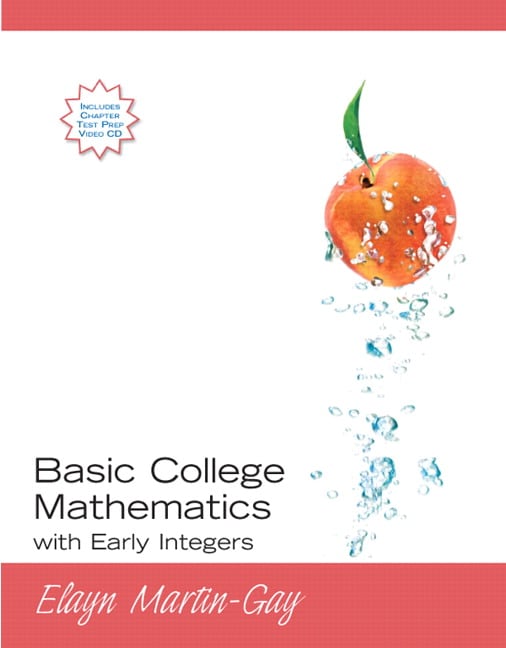
30.00$ - Purchase this E-book
Category : Higher Education
Chapter 1-The Whole Numbers 1.1 Tips for Success in Mathematics 1.2 Place Value and Names for Numbers 1.3 Adding Whole Numbers and Perimeter 1.4 Subtracting Whole Numbers 1.5 Rounding and Estimating 1.6 Multiplying Whole Numbers and Area 1.7 Dividing Whole Numbers Integrated Review — Operations on Whole Numbers 1.8 An Introduction to Problem Solving 1.9 Exponents, Square Roots, and Order of Operations Chapter 2 — Integers and Introduction to Variables 2.1 Introduction to Variables and Algebraic Expressions 2.2 Introduction to Integers 2.3 Adding Integers 2.4 Subtracting Integers Integrated Review — Integers 2.5 Multiplying and Dividing Integers 2.6 Order of Operations Chapter 3 — Fractions 3.1 Introduction to Fractions and Mixed Numbers 3.2 Factors and Simplest Form 3.3 Multiplying and Dividing Fractions 3.4 Adding and Subtracting like Fractions and LCD (Least Common Denominator) Integrated Review — Summary on Fractions and Operations on Fractions 3.5 Adding and Subtracting Unlike Fractions 3.6 Complex Fractions, Order of Operations, and Mixed Numbers 3.7 Operations on Mixed Numbers Chapter 4 — Decimals 4.1 Introduction to Decimals 4.2 Adding and Subtracting Decimals 4.3 Multiplying Decimals and Circumference of a Circle 4.4 Dividing Decimals Integrated Review — Operations on Decimals 4.5 Fractions, Decimals and Order of Operations 4.6 Square Roots and the Pythagorean Theorem Chapter 5 — Ratio, Proportion, and Measurement 5.1 Ratios 5.2 Proportions 5.3 Proportions and Problem Solving Integrated Review — Ratio and Proportion 5.4 Length: U.S. and Metric Systems 5.5 Weight and Mass: U.S. and Metric Systems 5.6 Capacity: U.S. and Metric Systems 5.7 Conversions Between the U.S. and Metric Systems Chapter 6 — Percent 6.1 Percents, Decimals, and Fractions 6.2 Solving Percent Problems Using Equations 6.3 Solving Percent Problems Using Proportions Integrated Review — Percent and Percent 6.4 Applications of Percent 6.5 Percent and Problem Solving: Sales Tax, Commission, and 6.6 Discount 6.7 Percent and Problem Solving: Interest Chapter 7 — Statistics and Probability 7.1 Reading Pictographs, Bar Graphs, Histograms, and Line Graphs 7.2 Reading Circle Graphs Integrated Review — Reading Graphs 7.3 Mean, Median, and Mode 7.4 Counting and Introduction to Probability Chapter 8-Equations 8.1 Introduction to Variable Expressions 8.2 Solving Equations: The Addition Property 8.3 Solving Equations: The Multiplication Property Integrated Review — Expressions and Equations 8.4 Solving Equations with Both Properties 8.5 Equations and Problem Solving Chapter 9 — Geometry 9.1 Lines and Angles 9.2 Plane Figures and Solids 9.3 Perimeter 9.4 Area 9.5 Volume and Surface Area Integrated Review — Geometry Concepts 9.6 Congruent and Similar Triangles Appendices: A. Tables 1. Addition Table and One Hundred Addition Facts 2. Multiplication Table and One Hundred Multiplication Facts 3. Table of Geometric Figures 4. Table of Percent, Decimal, and Fraction Equivalents 5. Table on Finding Common Percents of a Number 6. Table of Squares and Square Roots 7. Compound Interest Table B. The Bigger Picture 1. Adding and Subtracting Polynomials 2. Multiplication Properties of Exponents 3. Multiplying Polynomials Table of Contents
C. Exponents and Polynomials
Get Basic College Mathematics with Early Integers by Elayn Martin-Gay, University of New Orleans, Lakefront


0 commentaires:
Enregistrer un commentaire